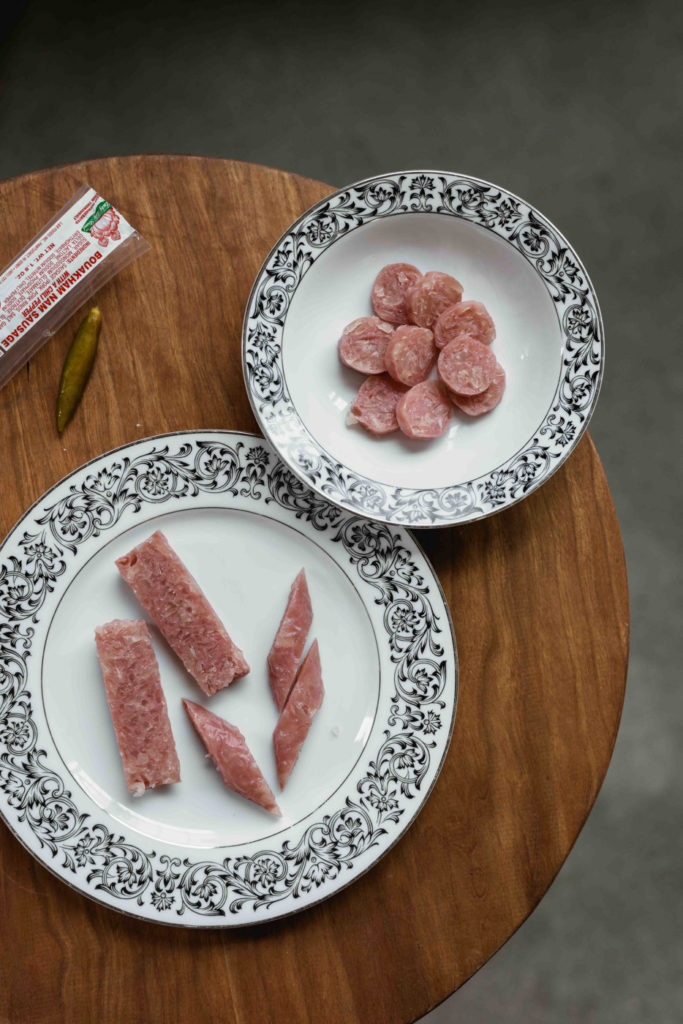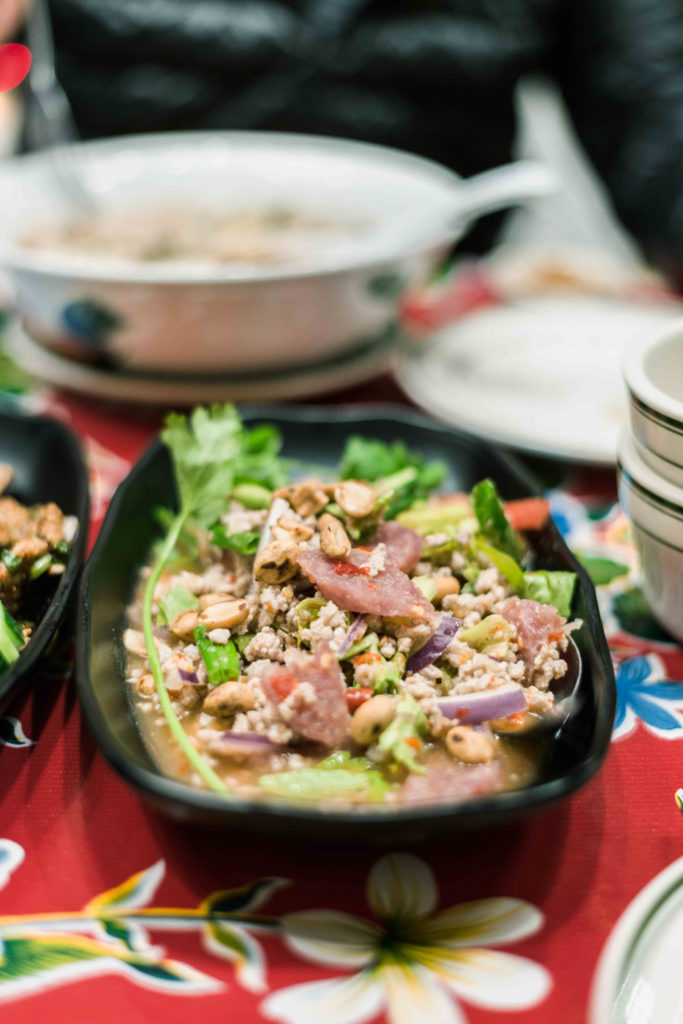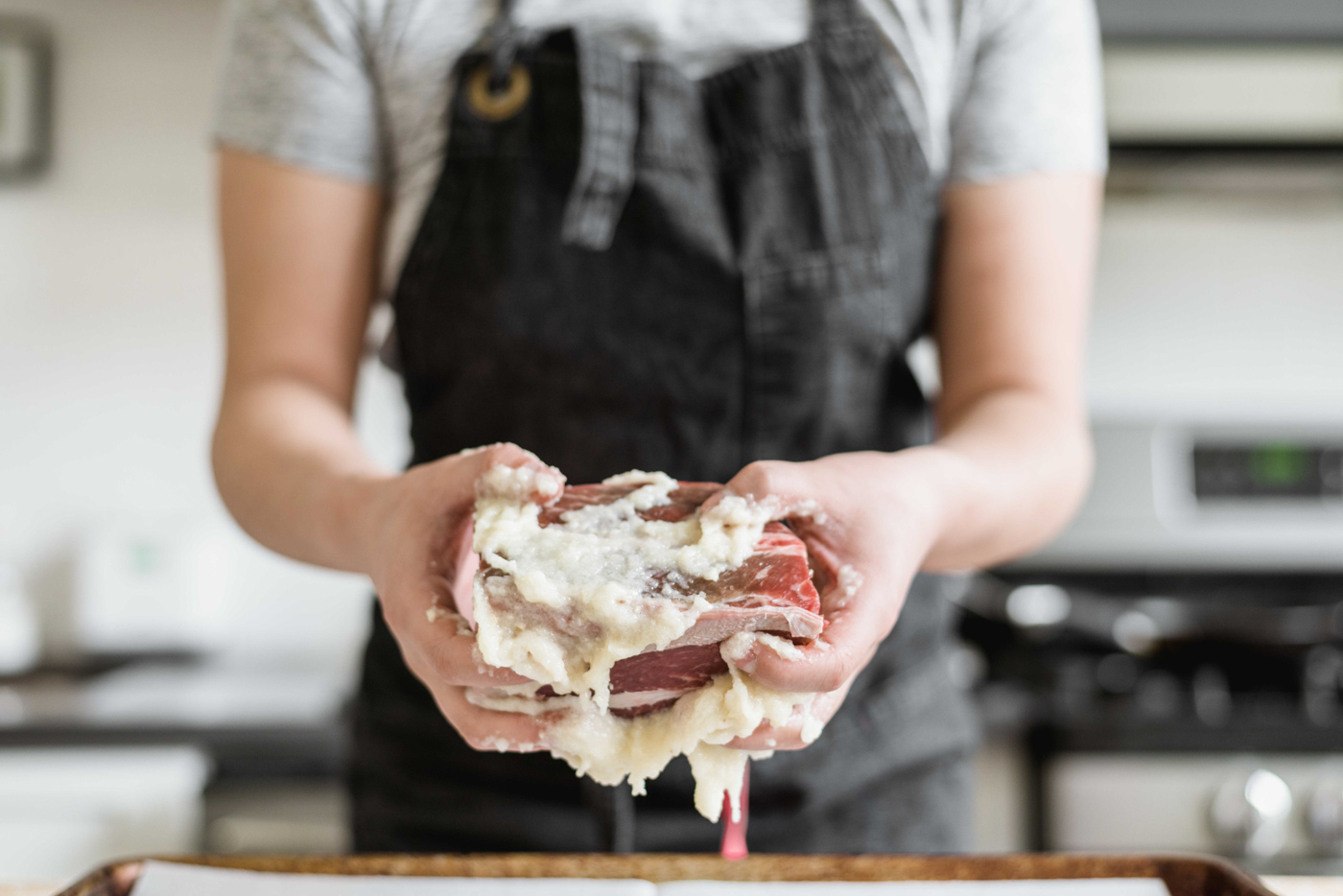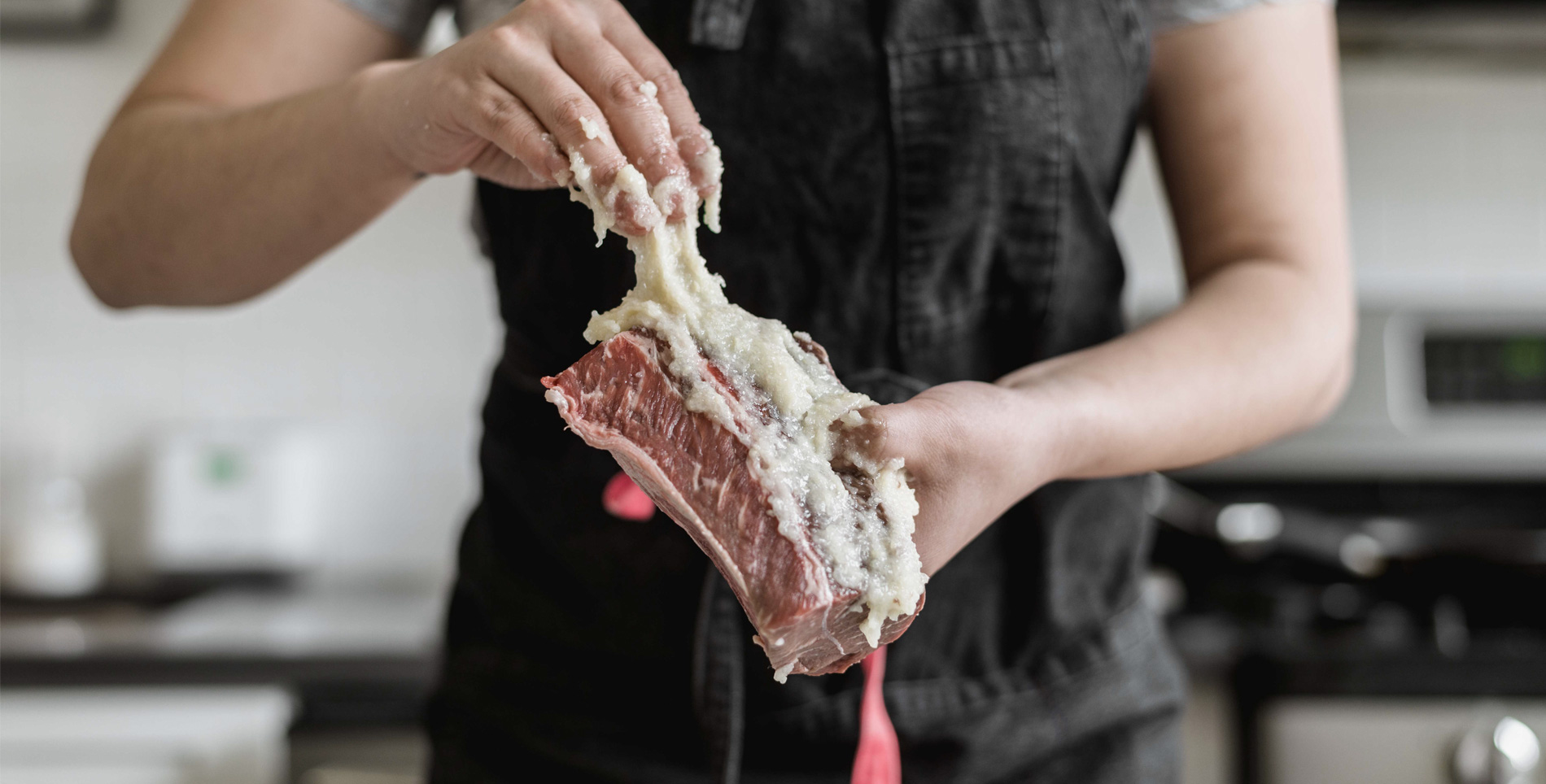For the second time this week, my hands are a sweet, sticky mess. I’m slathering a mix of steamed glutinous rice, garlic and salt onto raw beef short ribs, coaxing a partnership between warm paste and cool meat. I pinch at the cubed end with one hand and twirl the last strands of paste with the other, encasing each piece of rib meat. They line up neatly in the vacuum-sealed bag, a blend of off-white with peeks of pink, ready to start the fermentation cycle.
Five days, the color of the ribs have deepened considerably and the once-thick paste has unwound. I cut open the bags and take a whiff of its contents. The pungency of the garlic is gone, replaced by mellow sour notes accentuated with a pleasant, sake-like scent. I grill up each rib with great relish, every window in my apartment flung open, the char of meat and rice filling my nostrils and eyes. It takes another hour to finish the cooking process, but it’s all worth the work for that first bite: sour and salty, with an umami-rich fragrance that keeps me salivating and craving more.
I’ve been a diehard fan of the naem style of fermentation ever since I stumbled across a post from Leela Punyaratabandhu (colloquially known by her blog “SheShimmers”) about naem si krong mu, or naem style pork ribs, after returning home from a short trip to Thailand. I had stuffed myself with soured sausages, puzzling over its sour, salty and sweet complexities that seemed to evolve and deepen as I chewed. I didn’t know what the process was to create such a magical change in the meat, but I knew I wanted to find out. Punyaratabandhu’s recipe spurred a frenzy in my kitchen as I began to experiment on every meat I could get my hands on: lamb riblets, beef short ribs, even some goat chops I chanced upon at the butcher.
Naem is most commonly used to refer to soured pork sausages, found in almost every market in the Northeastern (Isan) region of Thailand. The presence of naem is particularly pronounced in this region due to its landlocked geography and subsequent focus on raising pigs and using pork in the cuisine. Nearby regions of Laos and Vietnam also have their own versions of lacto-fermented pork similar to naem, such as som moo and nem chua. It’s important to note naem can also refer to the fermentation style used to sour these sausages, so it should be understood in the context of both a noun and a modifier.



The ingredient list in a classic naem sausage is short: ground pork, pork skin, salt, sticky rice and garlic. Instead of being stuffed into casings, the mixture is typically packed into large, covered pots and sold by weight (naem maw, maw translating to “pot”), or bundled into cylinders with banana leaves or plastic (naem taeng, taeng translating to “cylinder”). Whole Thai chilies dot the exterior of both naem varieties—they are frequently eaten alongside the naem, but are not incorporated into the initial mixture.
The hallmark of naem is a sourness of the finished meat product, which comes from the process of lactobacillales (lactic acid bacteria) eating the sugar from the sticky rice and converting that into lactic acid. Lactobacillales occurs naturally in the environment and span numerous different strains, so those eating and making naem the classic way—allowing for wild fermentation—can expect slight variations of flavor from each batch. Because lactobacillales is salt tolerant, naem employs a high salt content coupled with the development of lactic acid to prevent the development of problematic bacteria such as clostridium botulinum (which cannot reproduce at pH levels below 4.6). The length of the fermentation process depends on temperature and humidity; for a speedy ferment, eighty-four degrees Fahrenheit and fifty percent humidity results in great tasting naem in a mere three to five days, whereas cooler temperatures (including refrigerating the mixture) still allow for lactobacillales activity but require more time. Given the popularity of naem and its propensity to be eaten raw, the product is now regulated for bacterial content, giving rise to the use of commercially produced fermentation additives like curing salt (which contains sodium nitrite) and naem powder mix (a combination of curing agents, preservatives and salt).
Naem in sausage form is a chameleon ingredient that can be utilized in many shapes and sizes, from being ground for naem khao tod (a salad made with crumbled, fried naem and rice balls) to being grilled and served with sticky rice, to simply sliced and served raw with Thai chilies, ginger and peanuts. It’s intense and tangy both cooked and raw, yet very different. Raw naem has a bouncy chew from the pork skin and a more direct sourness that starts as a tart top note before being grounded by the pork’s meatiness. Cooking naem crisps the outer pieces of pork skin and chars the pork to add counterbalancing smoky and lightly bitter flavors to the sourness. For those who favor the cooked naem, you’ll likely also enjoy sai krok isan, another sausage from the Isan region that undergoes the sticky rice lacto-fermentation, but is packaged more traditionally in sausage casing, tied into small links and served grilled.
I could sing the praises of naem all day long, the most enthusiastic bit being its use for all meats, not just ground pork. My favorite preparation method for a naem fermented dish brings us back to the start of this piece: employing lactobacillales to sour boneless beef short ribs (the name is a misnomer. This cut is from the shoulder of the cow and less fatty than bone-in short ribs) to be finished on the grill, then roasted, braised or sous-vide to medium rare. I find the results to be full of saturated, beefy flavor that sits surprisingly light in the belly. It stands up to flavorful vegetables, like mustard greens or pea vines, and even plays well with other funky and sour accompaniments like fermented fish broth or pickled plums. Whenever I find myself a little unsure of what to make, the whisper of naem always seems to prickle the air, and before I know it, I’m setting the timer on a cup of sticky rice.

Recipe
Naem Style Fermented Boneless Beef Short Ribs
Adapted from “Thai Soured Pork Ribs” recipe by SheSimmers
Yield: 1 lb. boneless beef shortrib
Ingredients:
- 680 g. (1.5 lb.) boneless beef short ribs, cut into roughly 2-by-4” rectangles
- 30 g. garlic, peeled, chopped
- 21 g. kosher salt (3% by weight of short ribs)
- 108 g. cooked sticky rice, cooled to room temperature
Prep Time: 1 hour
Fermentation Time: 3-5 days
Active Cook Time: 15 minutes
Inactive Cook Time: 48 hours
Method:
- Pat short ribs dry with paper towels.
- Thoroughly clean and dry garlic.
- Place garlic, sticky rice and kosher salt in food processor and process until the mixture turns into a sticky, smooth paste. Any visible garlic should be in small, even pieces.
- Prepare one or two suitably sized vacuum-sealer bags and prop them open wide.
- Using gloved hands, divide up the paste into roughly equal parts, matching the number of shortrib pieces you have. Scoop up the paste and slather all over each piece of shortrib making sure to cover all surfaces. Do this as quickly and in as few motions as possible, as the paste tends to begin sticking to your hands and itself instead of the shortrib.
- Carefully place short ribs into vacuum-sealer bags, avoiding the bag’s sides. Repeat until all pieces of shortrib are in bags.
- Vacuum seal each bag.
- Place shortrib in a warm, well-ventilated area inside your home. You’re aiming for a range of 75 degrees Fahrenheit to 85 degrees Fahrenheit with a humidity around 50%.
- After 3 to 5 days, remove short ribs from vacuum-sealer bags. Heat up a cast iron skillet or grill pan until smoking, fire up an outdoor grill. Place short ribs on skillet, grill pan or grill and sear or char on all sides until blackened.
- Prepare one or two suitably sized vacuum-sealer bags and prop them open wide. Preheat sous vide to 135 degrees Fahrenheit.
- Transfer charred short ribs into vacuum-sealer bags and seal. Place bags into water bath.
- Let shortibs cook sous-vide for 48 hours.
- After 48 hours, remove short ribs from vacuum-sealer bags. Blot short ribs dry with paper towels.
- Heat up a cast iron skillet or grill pan until smoking, fire up an outdoor grill. Place short ribs on skillet, grill pan or grill and sear or char on all sides for 30 seconds.
- Let short ribs rest 3 to 5 minutes before slicing and serving.
Notes:
- Choose fresh, high-quality beef from a purveyor you trust as well as fresh garlic. It’s best to use whole, organic garlic that you peel at home instead of using pre-peeled garlic.
- If you are nervous about fermenting raw meat, you can use a curing salt with nitrites, which is used to specifically inhibit the growth of botulism spores.
- If you end up using naem powder mix, which contains a mix of different curing agents and preservatives, follow the directions on the packaging for fermentation steps instead of these above because the bacteria used is not the same as those for lacto-fermentation. You can pick back up after the fermentation steps are complete.
- If you do not have a vacuum sealer, you can also place short ribs into a non-reactive container (i.e. glass jar) and pack it tightly to remove as much air as possible. This is important because lactobacillales works best in low-oxygen environments.
- If your home’s ambient temperature is different from the range above, adjust the fermentation time accordingly (adding a few days for cooler areas, removing a few days for warmer ones).
- The level of sourness in naem is very much a personal preference, so don’t be afraid to cut off a few pieces throughout the fermentation process to see at what point of the cycle you like the flavor most. Make sure to wear gloves and use clean (preferably sterilized) tools when interacting with the in-process naem, and to cleanly re-seal after each test.
- If you want to test the pH of your short ribs for safety, you can cut off a piece of the meat, add distilled water, blend into a liquid-y paste, and insert a pH strip. Your pH should be 4.6 or lower.
- The garlic may occasionally take on a greenish tint in the later stages of the fermentation process. This is not a cause for concern.
- You can skip the first round of grilling if you want to cut down on time, and simply plop the short ribs directly in the sous vide. I personally like having some of that charred flavor infusing into the shotribs, but it won’t dramatically change the final product if you skip the step. You will, however, need to grill the short ribs a little longer at the end to replicate the same surface char.
- If you do not want to sous vide the short ribs, you can also sear and braise them or roast them in the oven until your desired level of doneness.
- If you prefer a more well-done shortrib, you can raise the temperature of the sous vide to your preferred internal temperature.
- If you are not eating the short ribs right away after it comes out of the water bath, you can chill the short ribs down and keep them refrigerated (or frozen) until you are ready to eat them. Reheat them at the same temperature you cooked them initially.







Our comments section is for members only.
Join today to gain exclusive access.